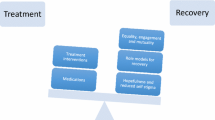Abstract
There is a continuous recognition in the literature of residential treatment of the need for studies to assess the impact of key variables which constitute a residential milieu on the treatment environment and, by implication, on the treatment outcome. One key variable is staff cohesion. The present study explored the effect of varying levels of staff cohesion on the treatment environment in a residential treatment center for disturbed adolescents. The results suggest that the variables Support, Personal Problem Orientation, Autonomy, Practical Orientation, and Staff Control are significantly affected by varying levels of staff cohesion. However, the clients' perception of their environment did not appear to be influenced by staff cohesion level.
Similar content being viewed by others
References
Bettleheim, B. (1974).A Home for the Heart, Bantam Books, New York.
Durkin, R., and Durkin, A. (1975). Evaluating residential treatment programs for disturbed children. In M. Guttentag, M., and Struening, E. (eds.),Handbook of Evaluation Research, Vol. 2, Sage, Beverly Hills, Calif.
Easson, W. M. (1969).The Severely Disturbed Adolescent: Inpatient Residential, and Hospital Treatment, International Universities Press, New York.
Goffman, E. (1961).Asylums, Doubleday-Anchor, New York.
Mikalachki, A. (1969).Group Cohesion Reconsidered, University of Western Ontario Press,
Moos, R. (1974a).Community Orientated Programs, Environment Scale, Manual and Test, Consulting Psychologists Press, Palo Alto, Calif.
Moos, R. (1974b).Evaluating Treatment Environments, Wiley, New York.
Redl, F. (1959). The concept of a therapeutic milieu.Am. J. Orthopsychiat. 29: 721–736.
Redl, F., and Wineman, D. (1952).Controls from Within, Free Press, New York.
Seashore, S. E. (1954).Group Cohesiveness in the Industrial Work Group, University of Michigan Survey Research Center, Ann Arbor, Mich.
Wheaton, B. (1974). Interpersonal conflict and cohesiveness in dyadic relationships.Sociometry 37: 328–48.
Additional information
Received M.A. from University of British Columbia, B.C., Canada. Current interests are process of psychotherapy, interpersonal conflict resolution.
Rights and permissions
About this article
Cite this article
Johnson, S.M. Staff cohesion in residential treatment. J Youth Adolescence 10, 221–232 (1981). https://doi.org/10.1007/BF02088972
Received:
Issue Date:
DOI: https://doi.org/10.1007/BF02088972



